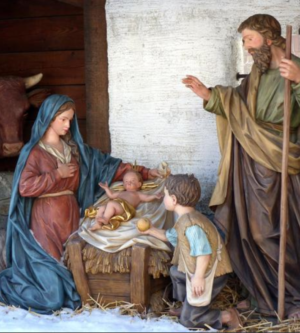“Someday soon we all will be together, if the fates allow. Until then we’ll have to muddle through somehow, and have yourself a merry little Christmas now.”
-“Have Yourself a Merry Little Christmas,” 1944
FRIDAY, DECEMBER 25: Christmas 2020 will look different for billions across the globe, as many are separated from family, friends and traditions due to the coronavirus pandemic. Still, we heartily say, in spite of the hardships and challenges: Merry Christmas!
In 1944, Judy Garland was the first to sing the famous ballad “Have Yourself a Merry Little Christmas” from the cinematic screen, in “Meet Me in St. Louis.” Perhaps in no year since that time—until this year—have the lyrics been so appropriate, again. Though many will be unable to visit family and friends for Christmas this year, virtual gatherings will be conducted in the hopes that, next year, “we all will be together.” (USA Today has a column on this subject.)
2020 NEWS: Since traveling to see family members is incredibly risky this year, experts say—only one state in the continental U.S. remains out of the “high risk” category for Covid-19 (and, Forbes lists the 10 highest-risk states)—many will be gathering virtually for Christmas and finding unique ways to share experiences. News articles worldwide are reporting on plans to drop off favorite dishes, gifts—even complete recipe ingredients—on the doorsteps of family members and friends. In this article from The Guardian, one family hopes to still enjoy Christmas dinner together, but in the outdoor garden (despite the weather); another woman plans to virtually play board games with faraway family members on Christmas Day.
To accommodate churchgoers on Christmas Day, many houses of worship are offering virtual, drive-in or outdoor Masses. In addition, Pope Francis has, by decree, issued permission for priests to say four Masses on Christmas Day in 2020.
CHRISTMAS: A MAJOR HOLIDAY FOR 2 BILLION CHRISTIANS
It’s Christmas Day for the majority of the world’s 2 billion Christians, as the birth of Jesus is celebrated in great rejoicing. While the birth year of Jesus is only speculated, December 25 is embraced by a multitude of Christians worldwide as the day Mary and Joseph welcomed their newborn son in a manger. With the celebration of Jesus’s birth, the season of Advent closes for Western Christians; the Nativity Fast ends for Eastern Christians; and the 12 days of Christmastide begin. In many countries, Christmas Day is a public holiday.
Note: Some Eastern Christians mark Christmas according to the Julian calendar, which pushes many Russian, Ukrainian and Serbian churches to a January 7 celebration of Nativity (Christmas).
Many Christians believe the birth of Jesus to Mary fulfills an ancient Messianic prophesy. Two canonical gospels record Jesus as having been born to Mary and her husband, Joseph, in the city of Bethlehem. Tradition tells that the birth took place in a stable, because “there was no room for them in the inn.” Nearby shepherds, told of the birth by angels, came to see the baby; magi came later, bearing gifts for the baby Jesus. The Star of Bethlehem is believed to have led the magi to Jesus, and the visit of the magi is celebrated as Epiphany, on January 6.
THE NATIVITY: A HISTORY
From the formative years of the church’s celebrations to the Nativity noted today, a multitude of customs have become associated with Christmas: displaying manger scenes, caroling, sending greetings and hanging stockings by a fireplace, to name just a few. Christian saints have been responsible for creating some of the customs—namely, St. Francis of Assisi for the nativity scene, and St. Nicholas for stockings and candy canes—while others are secular or even pre-Christian.
The Chronography of 354 AD is the oldest surviving reference to a Roman celebration for the birth of Jesus on December 25; in the East, the birth of Jesus was already observed with the Epiphany, on January 6. In the Early Middle Ages, Christmas Day was outshone by Epiphany, though by the later medieval period, Christmas-related holidays were starting to become more popular.
Christmas encountered turbulence through the 17th and 18th centuries, but by the 19th century, writers such as Charles Dickens were creating the “heartfelt goodwill” that morphed Christmas into a more secular holiday based on goodwill, family and jollity. For billions around the globe, Christmas today includes cookies, gift giving, shared feasts, cherished stories and songs and festive decorations.
EASTERN CUSTOMS: RUSSIA TO BETHLEHEM
Approximately half of Eastern Orthodox churches celebrate Christmas with Western Christians on December 25. That list includes the Orthodox churches in Bulgaria, Greece, Romania, Antioch, Constantinople, Alexandria, Albania, Cyprus and Finland—as well as the Orthodox Church in America.
For a variety of traditional reasons, Orthodox churches in Russia, Georgia, Ukraine, Moldova, Serbia, Armenia, Egypt and Ethiopia hold their Nativity (Christmas) observance in January. This variance primarily involves the older Julian calendar, which pushes Christmas to January 7, but further wrinkles in the tradition affect some Armenians, Copts and Ethiopians. The very last Eastern Orthodox Christmas will be celebrated by the Armenians living in Jerusalem, who travel to Bethlehem for an hours-long, centuries-old liturgy in the Church of the Nativity that takes place as late as January 18 or 19.
FOOD & RECIPES
In search of Christmas recipes? Look no further!
From Martha Stewart, try baking something beautiful.
From Food Network, find an array of professional recipes.
From AllRecipes, gather favored suggestions for dinner, breakfast and dessert.
From Food & Wine, cook up something fancy or unique.



Tell Us What You Think